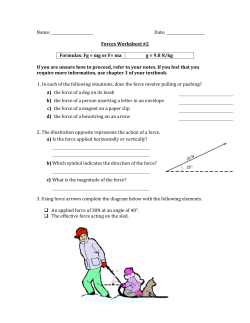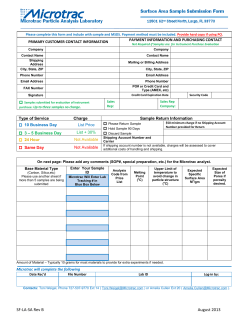
Ch. 37
1300
CHAPTER 37 Relativity
PROBLEMS
For instructor-assigned nomework, go to www.masteringphysics.com l S
Discussion Questions
Q!7.1. Yon arc !tanding on a train platfonn watching a high-speed
train pass by. A light inside one of the train cars is turned on and
then a little later it is turned off. (a) Who can measure the proper
time interval for the duration of the light: you or a passcnger on the
train? (b) Who can measure the propel' length of the train car, you
or a passenger on the train? (c) Who can measure the propcrkngth
of a sign attached to a post on the train platfonn, you or a passenger on the train? In each case explain your answer.
~ If simultaneity is not an ab&olutc concept:, dncs that mean
that we must discanl the concept of causality? If event A is to
cause event B, A mu!!: occur first. Is it possible that in SODlC
frames., A appears to be the cause of B, and in others, B appears to
be the cause of A ? Explain.
Qn3. A rocket is moving to the right at ! the speed of light relative to the earth. A light bulb in the center of a room inside the
rocket suddenly turns on. Call the light hitting the front end of the
room event A and the light bitting the back of the room event B
(Fig. 37.27). Which event occurs first. A or B or are they simultaneous, as viewed by (a) an astronaut riding in the:rockct and (b) a
person at rest on the earth?
Figure 37.27 Question Q37.3.
how do massless pBI1.ic1es such as photons and neutrinos acquire
thisspccd? Can't they start from rest and accelerate? Explain.
Q!7.II. The !pCCd of light rclative to still water is 2.25 X 10'1 m/s.
If the water is moving past us., the speed of light we measure
depends on the speed of the water. Do tbcsc facts violate Einstein's
second postulate? Explain.
Q!7.12. When a IIlOIlOcl!romat light SO\lICe DlOVCS toward an
obscrvcr, its wavclength appears to be !hort.cr than the value measured when the !IOIlfCe is at rest. Does this contradict the hypothesis
that the speed of light is the same for all observers? Explain.
Q!7.13. In principle, does a hot gas have more mass than the same
gas when it is cold? Explain. In practice, would this be a measurable effect? Explain.
Q!7.14. Why do you think the development of Newtonian mecllanics preceded the more refined relativistic mechanics by so many
years?
Exercises
Section 37.2 Relativity of Simultaneity
57.1. Suppose the two lightning bolts shown in Fig. 37.5a arc
simultaneous to an obscrva: on the train. Show that they arc not
simultaneous to an observer on the ground. Which lightning strike
does the ground observer measure to come first?
Section 37.3 Relativity of Time Intervals
Q37A. What do you think would be different in everyday life if the
spccdoflight were lOm/s instcad of 3.00 X 10' m/s?
Qn5. Tbc average life span in the United States is about 70 years.
Docs this mean that it is impossible for an avemge person to
travel a distmlce greater than 70 light-years away from the earth?
(A light-year is the distance light travels in a ycar.) Explain.
Qnl. You are holding an elliptical serving platter. How would
yon need to travel for the !Crving platter to appear round to another
ob..,.."
Qn7. Two events occur at the same space point in a particular
inertial frame of rdcrencc and are simultaneous in that frame. Is it
pOSSIble that they may not be simultaneous in a different inertial
frame? Explain.
QnI. A high-speed train passcs a train platfonn. LaIIy is a pasgenger on the train, Adam is standing on the train platform, and
David is riding a bicycle toward the platfOlID in the same direction
as the train is traveling. Compare the length of a train car as measured by Lmy,Adam, and David.
QnJ. Tbc thcmy of relativity sets an upper limit on the speed that
a particle can have. Are there also limits on the energy and
momentum of a particle? Explain.
Q!7.1o. A student asserts that a material particle must always have
a speed slower than that of light, and a massless particle must
always move at exactly the speed of light. I! she COITCct? If so,
57.2. The positive muon (p. +), an unstable particle,lives on average 2.20 X 10-6 s (measured in its own frame ofrcfcrence) before
decaying. (a) If SIlCb. a particle is moving, with respect to the laboratory, with a !pCCd of 0.9OOc, what average lifetime is IDC8!IlJ'Cd
in the laborat:oIy? (b) What avcmgc: distance, measured in the laboratory, does the particle move before decaying?
57.3. How fast must a rocket travel relative to the earth so that
time in the rocket ''slows down" to half its rate as IIIQI.!IllCd by
earth-based observers? Do present-day jet planes approach snch
-'
57.4. A spaceship flies past Mars with a speed of 0.985c relative to
the surface of the planet. When the spaceship is directly overhead,
a signal light on the Martian surface blinks on and then off. An
observer on Mars measures that the signal light was on for 75.0 1M.
(a) Docs the observer on Mars or the pilot on the !p8CC!hip measure the proper time? (b) What is the duration of the light pulse
measured by the pilot of the spaceship?
57.5. The negative pion ('JI' -) is an unstable particle with an average lifetime of 2.60 X 10-1 s (measured in the rest fnu:ne of the
pion). (a) If the pion is made to travel at vcty high speed relative to
a laboratory, its average lifetime is measured in the laboratory to
be 4.20 X 10-7 s. Calculate the speed of the pion expressed as a
:f:ra.ction of c. (b) What distance, measured in the labomtmy, docs
the pion travel during its average lifetime?
57." As you pilot your space utility vehicle at a constant speed
toward the moon, a race pilot flies past you in her spaceracer at a
constant speed of 0.8OOc relative to you. At the instant the spaceracer passcs you, both of you start timers at zero. (a) At the instant
when you measure that the spaceracer has traveled 1.20 X lr1m
past you, what docs the race pilot read on her timer? (b) When the
race pilot reads the value calculated in part (a) on her timer, what
does she measure to be your distance from her1 (c) At the instant
© Copyright 2024















